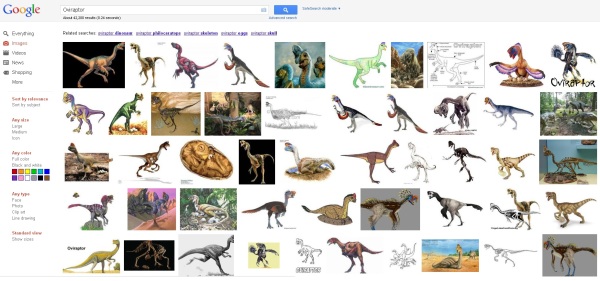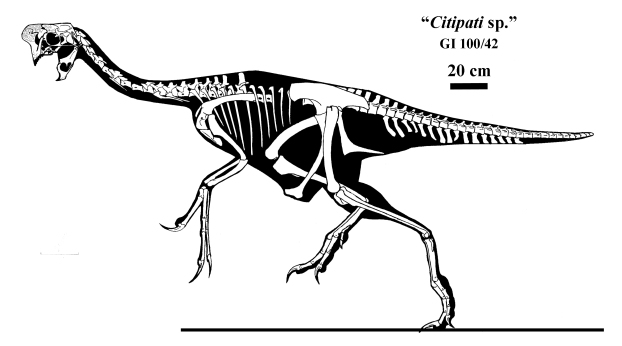One of my biggest pet peeves (when it comes to dinosaurs, anyway) is that when people are talking about Oviraptor, they aren’t actually talking about Oviraptor philoceratops. Mostly, they are talking about GI 100/42, because for the most part, that’s what was said to be Oviraptor for most of the last 50 years. A lot of this has to do with information: GI 100/42 is a nearly complete skeleton with a novel skull, it was featured heavily by Barsbold Rinchen beginning in the late 1970’s and this hasn’t let up since. The immense amount of mystery involved in this specimen, given it’s somewhat lackluster description in 1983 by Barsbold, is not even offset by the prevalence of it in media because what is being mentioned isn’t what it is being mentioned as.
Here’s an example:
Amazingly, one of these images is actually representative of Oviraptor philoceratops (meaning, based on AMNH FR 6517, the holotype and only known specimen). I’ll leave it to you, reader, to figure out which. One of the other images is based partial on this specimen, but has the skull of GI 100/42 on it, a re-drawing of Greg Paul’s skeleton as published in Predatory Dinosaurs of the World (1988).
Restricting the search criteria to “Oviraptor philoceratops,” however, increases the number of correct hits:
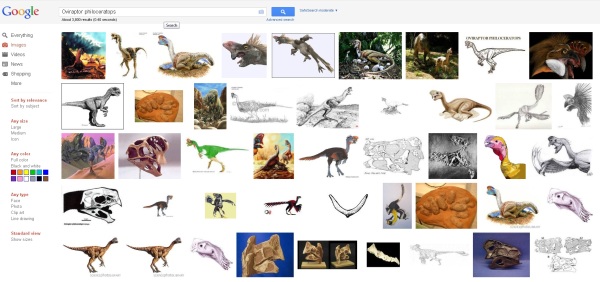
Screenshot of the first page of results for Google Images, where the criteria are expanded to “Oviraptor philoceratops.”
We get a lot better here. For one, there’s Marco Auditore’s skull of AMNH FR 6517 there on the bottom left, Luis Rey’s illustration of Bayn Zag on the top left, and even a few hits from my own site. But now we also have the “Mitrata” oviraptorids on the bottom center, from Witmer’s Lab (which labels them “Oviraptor”).
Interspersed among these include the oviraptorid skeleton combining parts of “Ingenia” yanshini and Conchoraptor gracilis (from a photo by National geographic photographer Louis Psihoyos, as displayed at Dinosaur Kingdom Nakasato in Nakasato Village, Gunma Prefecture, Japan), Mike Skrepnick’s painting of Nomingia gobiensis for Nature‘s feature on the presence of a nonavian pygostyle (Barsbold et al., 2000), and a ton of hits for GI 100/42.
On top of this, some of the most popularized books aimed at teaching about dinosaurs, such as Norman’s Encyclopedia of Dinosaurs and Paul’s PDW, confuse the issue. This is partly Barsbold’s fault, though, as he initially referred GI 100/42 to Oviraptor philoceratops, and no formal rejection of this argument has appeared in print until 2002, when Jim Clark, Mark Norell and Tim Rowe redescribed the skull of AMNH FR 6517 in part to resolve the issue of “what is Oviraptor philoceratops?”
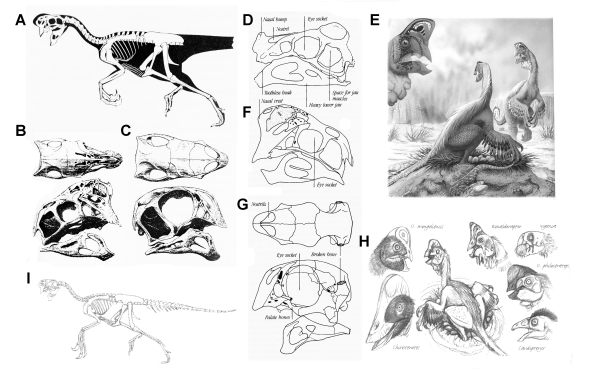
Popular depictions of “Oviraptor philoceratops.” A-C from Paul, 1988; D, F-G from Norman, 1986; E, H-I from Gee and Rey, 2003. A despicts the skull of GI 100/42 (as does B and F) while the body is represented by AMNH FR 6517, of which I is a redrawing with a completed tail and D is the skull of, after Osborn, 1924; the skull of ZPAL MgD-I/95, a small oviraptorid that may be juvenile and is certainly a Khaan-like “conchoraptorine,” is depicted in C and G (redrawn after Osmólska, 1986). E represents GI 100/42 from Gee and Rey, 2003, but there may be confusion whether GI 100/42 is an “adult” morph of this.
Virtually all oviraptorids are confused with Oviraptor philoceratops, and some authors (e.g., Paul, 2010) have conflated the issue by subsuming many taxa into one, presuming a priori that synonymy is the rule, rather than something that should be assessed by primary analysis.
So one of the things I want to do here is attempt to create a movement to correctly depict and label illustrations of oviraptorids:
If you’re going to depict Oviraptor philoceratops, use AMNH FR 6517 as your guide. I understand that it’s difficult because the skull is in pretty bad condition and doesn’t give you the snazzy look of GI 100/42. But that’s what happens with limited material. I’ve gone through some pains to try to create an accurate piece of skeletal art to facilitate this.
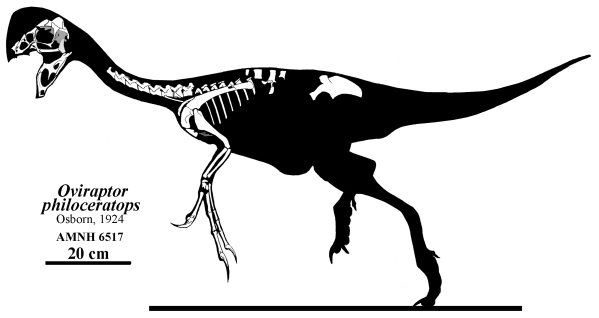
Skeletal reconstruction of AMNH FR 6514, holotype of Oviraptor philoceratops Osborn (1924). Shown are all preserved material.
Yeah, I know, it’s not much. This is what Oviraptor philoceratops is. Not this:
Barsbold R. 1976. О новом позднемеловом семействе мелкиж теропрод (Oviraptoridae fam. n.) Монголий (A new Late Cretaceous family of small theropods (Oviraptoridae fam. n.) in Mongolia). Доклады Академии наук, СССР — Doklady Akadyemii nauk, S.S.S.R. 226:685-688. (in Russian)
Barsbold R., Currie, P. J., Myhrvold, N. P., Osmólska, H., Tsogtbaatar K. & Watabe M. 2000. A pygostyle from a non-avian theropod. Nature 403:155-156.
Barsbold R. 1983. Жыщнйе динозаврй мела Монголий (Carnivorous dinosaurs from the Cretaceous of Mongolia). Трудй – Совместная Совестко-Монгольской Палеотологыческая Зкспедитсия — Joint Soviet-Mongolian Paleontological Expedition, Transactions 19: 1-120. (in Russian, w/ English summary)
Clark, J. M., Norell, M. A. & Rowe, T. 2002. Cranial anatomy of Citipati osmolskae (Theropoda, Oviraptorosauria), and a reinterpretation of the holotype of Oviraptor philoceratops. American Museum Novitates 3364:1-24.
Gee, H. & Rey, L. V. 2003. A Field Guide to Dinosaurs: The Essential Handbook for Travelers in the Mesozoic. Barron’s Educational Series, Inc.
Norman, D. M. 1986. The Illustrated Encyclopedia of Dinosaurs. Gramercy Publishing (New York City).
Osmólska, H. 1976. New light on the skull anatomy and systematic position of Oviraptor. Nature 262:683–684.
Paul, G. S. 1988. Predatory Dinosaurs of the World: A Complete Illustrated Guide. Simon & Schuster (New York City).

